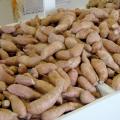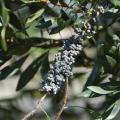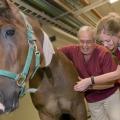News From 2009
MISSISSIPPI STATE – The arts, history and music of the past will be celebrated at the seventh annual Piney Woods Festival at Mississippi State University’s Crosby Arboretum in Picayune.
The festival will provide an opportunity for attendees to have fun while learning about the early days of the Piney Woods region.
“The arboretum provides the perfect setting for learning about arts and heritage crafts,” said Patricia Drackett, the arboretum’s senior curator. “We want to preserve those arts by providing a fun and interactive event.”
MISSISSIPPI STATE – A very wet September and October left most of the state’s soil saturated, as many places have had gotten rain in almost statistically impossible quantities.
Charles Wax, state climatologist and professor of geosciences at Mississippi State University, said February and May were unusually wet across much of the state, and the summer had few periods of dry weather. This caused many areas to have above-normal yearly rainfall totals when fall arrived. Then starting in September, rainfall began accumulating rapidly.
By Karen Templeton
MSU Ag Communications
MISSISSIPPI STATE – As Mississippi’s sweet potato industry continues to grow, researchers at Mississippi State University are developing even more innovative and effective strategies for growers.
By Norman Winter
MSU Horticulturist
Central Mississippi Research & Extension Center
In my region, the southern wax myrtle reigns supreme. When I say “my region,” you might think I mean the Deep South, but actually it stretches from Texas to the East Coast and as far north as New Jersey. You could not ask for a better small tree to act as a privacy screen around a porch, patio, deck, or garden bath or to soften harsh walls. Coastal residents are always looking for plants tolerant of salt spray, and wax myrtles are among the best.
MISSISSIPPI STATE -- Temple Grandin, an animal scientist from Colorado State University, thinks in pictures, a characteristic that gives her valuable insight in how to handle animals.
Grandin is a best-selling author and a world-renowned speaker. She also has autism. Grandin was the keynote speaker at CVM’s Human-Animal Bond lecture series in late October. She has been instrumental in developing welfare guidelines for handling and transporting livestock and is a past member of the board of directors of the Autism Society of America.
MISSISSIPPI STATE -- Mississippi cut flower growers who want to reach new markets by improving their business savvy can attend a regional short course Nov. 17-18 in Memphis.
The event will be at the Hilton Memphis at 939 Ridge Lake Blvd. The $85 preregistration for two days is due Nov. 10, and onsite registration is $125. The cost for a single day is $70, either by preregistration or onsite enrollment.
By Karen Templeton
MSU Ag Communications
MISSISSIPPI STATE – Heavy rains in Mississippi and nationwide have decreased the number of pumpkins available for harvest, but not the quality of the pumpkins already pulled from the fields.
Pumpkins are popular in the fall for decorating and baking, but they are not a major crop for Mississippi, which only has a few commercial growers.
MISSISSIPPI STATE -- Mississippi State University’s College of Veterinary Medicine is preparing to host a nationally known animal scientist who frequently addresses parents and teachers about her life with autism.
Temple Grandin, a professor of animal science at Colorado State University, will speak Tuesday as part of the second annual Human-Animal Bond Lecture Series Oct. 19-23. It will celebrate the unique interdependence between people and animals -- companion, production, lab animal and wildlife. The series is sponsored by Nestle Purina PetCare Co.
MISSISSIPPI STATE -- Two years of hard work and commitment to reactivate Mississippi State University’s 4-H chapter paid off when the Southern Region Collegiate 4-H selected the club to host its 2009 annual conference.
Representatives of collegiate 4-H clubs from 13 states will take part in workshops and participate in several service projects.
MISSISSIPPI STATE – Inconsistencies in soybean grading last year led the state’s soybean industry to take steps to educate producers and grain elevator staff on how to determine the kind and amount of damage soybeans have.
Industry supporters developed the Mississippi Soybean Producer’s Field Guide to Soybean Damage as a handy, pocket reference for producers. They also held four grading clinics where they gave grain elevator operators a half-day refresher course in soybean grading.
By Norman Winter
MSU Horticulturist
Central Mississippi Research & Extension Center
As I was touring the landscape of an Southeastern college, I noticed that everywhere I looked was a native dogwood. I couldn’t help but think to myself, “This dogwood is for the birds.”
My thought was not too far off because this small tree feeds 28 species of birds, including quails and turkeys. Deer and squirrels also love the fruit, making this tree an all-star for those wanting a backyard wildlife habitat.
MISSISSIPPI STATE – A 350-acre area of deep ravines and bluff ridges in Webster County is being preserved to protect its plant and animal diversity that resembles that of the Appalachian Mountains.
The Appalachian Mountains stretch from Alabama to Canada with foothills in northeastern Mississippi. Some 100 miles from these foothills is an area in central Mississippi known as Old Cove. The land is owned by Weyerhaeuser Co. and is home to mature hardwoods, rock outcroppings, reptiles, amphibians and many plant species.
MISSISSIPPI STATE – Mississippi State University entomologist Richard Brown and two co-authors will be given the Editor’s Choice Award for writing one of the best entomological articles of 2008.
Brown and his colleagues will receive the award in December from the Entomological Society of America. The article, “Tracing an Invasion: Phylogeography of Cactoblastis cactorum in the United States Based on Mitochondrial DNA,” was published in the Annals of the Entomological Society of America.
By Norman Winter
MSU Horticulturist
Central Mississippi Research & Extension Center
Gardeners can rejoice since it is pansy-planting time across much of the country. While this is a good thing, the question is always asked, “What do I plant with them?”
One of my favorites to partner with pansies is sweet alyssum. No matter where you live in the country, at some time during the year you can grow both pansies and alyssum together for a magnificent olfactory experience.
By Patti Drapala
MSU Ag Communications
MISSISSIPPI STATE – The tradition of passing parenting skills from one generation to the next is being lost as traditional family structures change, but the Mississippi State University Extension Service is nurturing a program that helps young mothers and fathers cope.
By Karen Templeton
MSU Ag Communications
MISSISSIPPI STATE – Two Mississippi State University pathology laboratories work together to diagnose animal diseases across the state and also serve two important yet different missions.
The College of Veterinary Medicine laboratories in Starkville and Pearl work within the Mississippi Veterinary Research and Diagnostic Laboratory System to provide veterinarians, producers and researchers with quality diagnostic services.
MISSISSIPPI STATE – Veterinarians are the doctors of the animal world, and certified veterinary technicians are the “nurses” who are trained and certified to care for patients and provide much of the medical care the animals receive.
Only veterinarians can legally diagnose, prescribe and perform surgery. Veterinary technicians, commonly called vet techs, can perform all other procedures and tasks completed in veterinary practice. Mississippi State University will soon offer a new degree program to train future vet techs for this important work.
By Patti Drapala
MSU Ag Communications
MISSISSIPPI STATE -- Horses can be intimidating and unpredictable, but Mississippi State University programs that have equine components can help people feel more comfortable with these powerful, large animals.
Animal Health …
Some students at the MSU College of Veterinary Medicine do not have any riding or handling experience with horses. Dr. Bob Linford, a veterinary surgeon and professor, uses his experience as a teacher and horse enthusiast to help them gain confidence.
MISSISSIPPI STATE – Harvest season rains have robbed soybean growers of strong yields and bean quality, reducing profits in an already challenging year.
“We were harvesting a beautiful crop with outstanding yields before the rains came the last two weeks of September,” said Trey Koger, soybean specialist with the Mississippi State University Extension Service. “Now that farmers are finally back in fields, we are seeing average yield losses of 5 percent to 10 percent.”
In addition to the yield losses, damage estimates average between 5 percent and 20 percent.
Pages
News Types
- Crop Report (428)
- Feature Story (5905)
- Feature Photo (53)
- Extension Outdoors (319)
- Southern Gardening (1481)
- Extension Inbox (95)
Archive
- 2025 (97)
- 2024 (186)
- 2023 (182)
- 2022 (183)
- 2021 (176)
- 2020 (211)
- 2019 (222)
- 2018 (276)
- 2017 (336)
- 2016 (381)
- 2015 (456)
- 2014 (495)
- 2013 (487)
- 2012 (491)
- 2011 (354)
- 2010 (320)
- 2009 (313)
- 2008 (272)
- 2007 (263)
- 2006 (252)
- 2005 (278)
- 2004 (270)
- 2003 (279)
- 2002 (227)
- 2001 (238)
- 2000 (241)
- 1999 (231)
- 1998 (231)
- 1997 (239)
- 1996 (58)
- 1995 (36)











